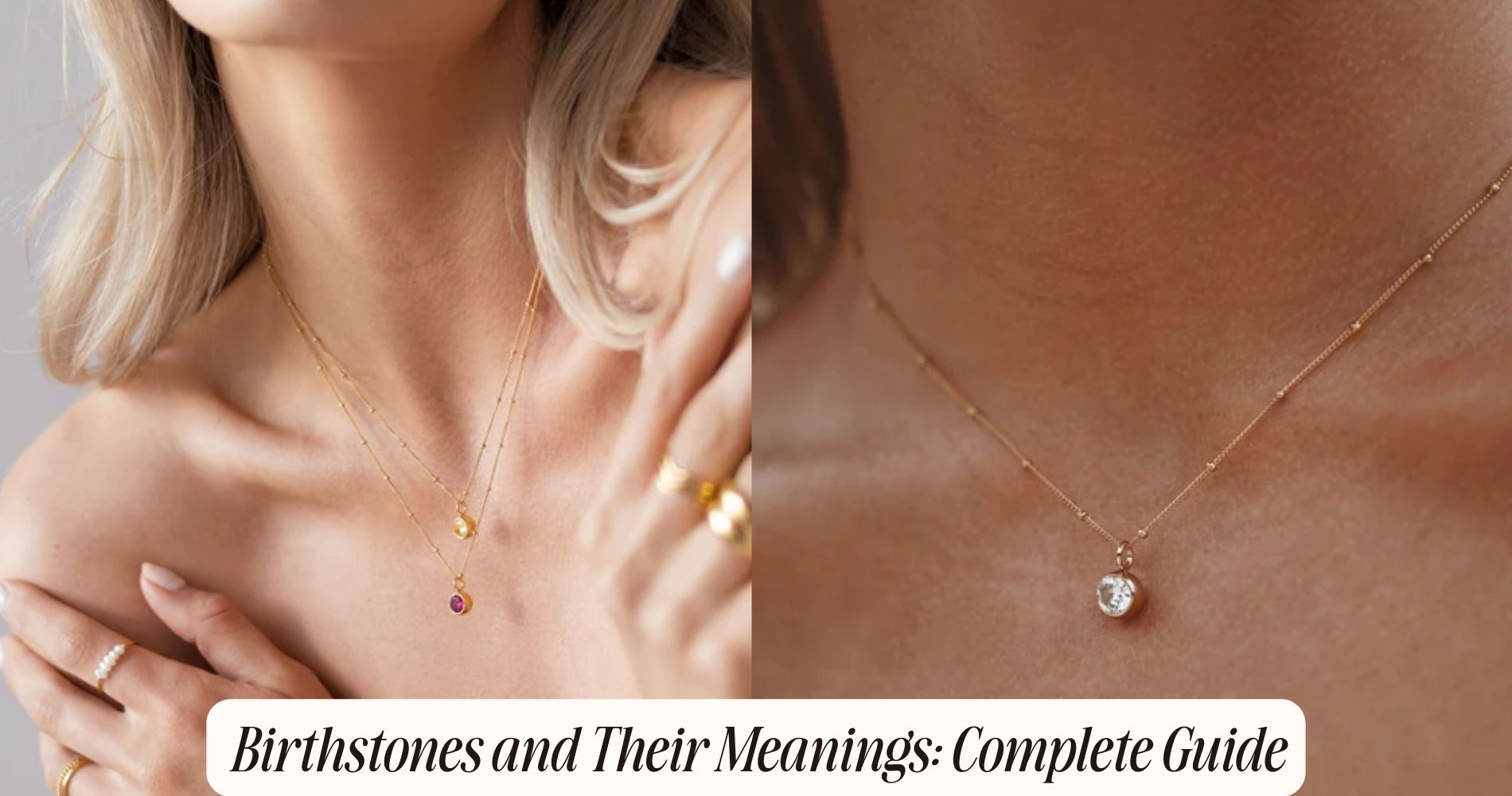
Birthstones and Their Meanings: Complete Guide
Origins of Birthstones
The origins of birthstones trace back to ancient civilizations that assigned gemstones to each month based on their cultural beliefs and astrological significance. You can find the earliest evidence of this practice in biblical texts and ancient cultures such as the Babylonians and Egyptians, who believed that gemstones held mystical properties. Each stone was thought to possess unique powers that could influence an individual's destiny and health.
The significant origins of birthstones are particularly notable. In the Book of Exodus, the Breastplate of Aaron, a ceremonial religious garment, featured twelve stones representing the twelve tribes of Israel. This connection laid the foundation for associating specific gemstones with certain times of the year. Ancient beliefs also played an essential role in these assignments. Different civilizations attributed various gemstones to their gods and celestial bodies, believing that wearing these stones during the corresponding month could harness their divine energies.
Over centuries, these ancient beliefs evolved and merged with astrological traditions, leading to the modern birthstone system. Today, you wear your birthstone not just as a decorative accessory but as an embodiment of age-old wisdom and cultural heritage.
January: Garnet
Garnet, the birthstone for January, symbolizes protection and vibrancy, often revered for its deep red hues and purported healing properties. Its name originates from the Latin word 'granatum,' meaning pomegranate, due to its resemblance to the fruit's seeds.
Garnet varieties extend beyond the typical red, including hues like green (Tsavorite), orange (Spessartine), and even color-changing forms (Alexandrite-like Garnets).
Garnet symbolism is rooted in ancient cultures. Ancient Egyptians used garnets as talismans for protection against evil, while Romans believed garnets conferred health and strength. Scientifically, garnets are a group of silicate minerals with similar crystal structures but differing chemical compositions. Their hardness on the Mohs scale ranges from 6.5 to 7.5, making them suitable for various types of jewelry.
Modern gemologists appreciate garnets not only for their aesthetic appeal but also for their unique optical properties, such as high refractive indices and brilliance.
Whether you choose a classic red garnet or opt for one of the rarer garnet varieties, wearing this gemstone connects you to a rich tapestry of historical significance and geological wonder. Garnet's enduring charm truly makes it a gem for all time.
February: Amethyst
As January's garnet symbolizes protection, February's amethyst embodies tranquility and spiritual growth with its enchanting purple hues. This quartz variety ranges from deep violet to soft lavender, owing its color to iron and irradiation. Amethyst's calming properties are well-documented, making it a popular choice for stress relief and meditation.
Amethyst's mythological connections are rich and varied. In ancient Greek lore, the stone was linked to Bacchus, the god of wine. It's said that the stone could prevent intoxication, earning its name from the Greek word 'amethystos,' meaning 'not drunk.'
Medieval European soldiers wore amethyst amulets for protection in battle, believing the stone could heal wounds and keep them cool-headed.
When it comes to celebrity associations, amethyst remains a favorite. Celebrities like Meghan Markle and Kate Middleton have been spotted wearing amethyst jewelry, showcasing its timeless appeal. Its versatility and elegance make it suitable for both everyday wear and special occasions.
Scientifically, amethyst is a silicon dioxide crystal, with a hardness of 7 on the Mohs scale, ensuring durability. Whether you're seeking spiritual growth or simply love its stunning color, amethyst offers both beauty and metaphysical benefits.
March: Aquamarine
You'll find aquamarine, the birthstone for March, steeped in historical significance and renowned for its healing properties.
Romans believed it could protect sailors and guarantee safe voyages, reflecting its deep connection with the sea.
In modern crystal therapy, aquamarine is praised for its ability to soothe the mind and enhance clarity.
Historical Significance
Aquamarine, the birthstone for March, has been treasured since ancient times for its alleged ability to calm the seas and guarantee safe voyages. Ancient civilizations, such as the Greeks and Romans, believed that aquamarine possessed a divine connection to the sea. Sailors would carry aquamarine amulets, convinced these gemstones could safeguard them from perilous waters and vengeful sea deities.
Cultural beliefs surrounding aquamarine extended beyond maritime safety. In medieval Europe, it was thought that aquamarine could rekindle love and maintain harmony between married couples. This gemstone was often used in betrothal and wedding rings, symbolizing a promise of fidelity and enduring affection.
Additionally, ancient Egyptians placed aquamarine in tombs, believing it would offer protection in the afterlife and ensure a journey into the next world filled with tranquility.
Scientifically, aquamarine is a variety of the mineral beryl, its blue-green hue resulting from traces of iron. Historical texts and archaeological findings corroborate its esteemed status across various cultures and epochs.
As you explore the historical significance of aquamarine, consider how its storied past continues to influence its reputation and desirability today. This rich history underscores the timeless appeal and cultural importance of aquamarine.
Healing Properties
Many believe that aquamarine's unique properties can promote mental clarity and emotional balance. This gemstone is often linked to the throat chakra, which governs communication and self-expression. By wearing or meditating with aquamarine, you can potentially enhance your ability to articulate thoughts clearly and honestly. Such alignment is important for fostering effective communication and reducing misunderstandings in both personal and professional settings.
Aquamarine's calming energy is also thought to help with emotional balance. If you're feeling overwhelmed or stressed, holding an aquamarine stone may help to soothe your mind. Its tranquil blue color is reminiscent of serene ocean waters, promoting a sense of peace and relaxation. This can be particularly beneficial for those who struggle with anxiety or emotional turbulence.
Additionally, aquamarine is believed to have purifying effects, which can aid in detoxifying the body and spirit. This cleansing property is said to support overall well-being by clearing negative energies and enhancing your aura.
April: Diamond
April's birthstone, the diamond, is renowned for its exceptional hardness and unparalleled brilliance, making it a symbol of strength and enduring love. Diamond symbolism extends beyond mere aesthetics; it's deeply rooted in the stone's intrinsic properties. With a Mohs hardness rating of 10, diamonds are the hardest natural material on Earth. This incredible durability symbolizes unbreakable bonds and steadfastness, making diamonds a fitting representation of eternal commitment.
When you select a diamond, you're choosing a gemstone that's not just visually stunning but also scientifically remarkable. Diamonds are composed of carbon atoms arranged in a crystal lattice, which accounts for their extraordinary hardness. This structure allows them to resist scratching and maintain their luster over time, ensuring your gemstone remains brilliant for generations.
Moreover, diamonds exhibit a high refractive index, leading to exceptional light dispersion and a fire-like sparkle. The interplay of light within the gemstone enhances its visual appeal, making it a timeless choice for jewelry.
Whether you're celebrating an April birthday or a significant milestone, the diamond's blend of scientific marvel and symbolic depth offers an unmatched allure.
May: Emerald
May's birthstone, the emerald, captivates with its vibrant green hue and storied history as a symbol of rebirth and wisdom. This precious gem owes its striking color to trace amounts of chromium and vanadium.
Emerald folklore is rich, spanning various cultures; the ancient Egyptians considered it a symbol of eternal life, while the Romans associated it with Venus, the goddess of love and beauty.
Scientifically, emeralds belong to the beryl mineral family and rank between 7.5 and 8 on the Mohs scale of hardness. Despite their relatively high hardness, emeralds often contain inclusions, known as 'jardin,' which can affect their durability and clarity.
Astrological connections further enhance the emerald's allure. In Vedic astrology, emeralds are linked with the planet Mercury, believed to enhance intellectual capabilities and communication skills. Western astrology also associates emeralds with the Taurus zodiac sign, attributing traits like loyalty, determination, and sensuality to those born in May.
When choosing an emerald, consider its color, clarity, cut, and carat weight. The most prized emeralds exhibit a deep, vivid green with minimal inclusions.
Whether for its aesthetic appeal or its rich symbolic meanings, an emerald makes a timeless and meaningful choice.
Conclusion
You've now explored the origins and meanings of birthstones from January to May. Each stone, from Garnet to Emerald, carries unique properties and historical significance.
Whether you're drawn to the protective qualities of Amethyst or the enduring allure of Diamonds, these gems offer more than just beauty. Understanding their backgrounds and meanings adds depth to your appreciation.
As you continue your journey, let this guide be your scientific and analytical companion.
























Leave a comment
This site is protected by hCaptcha and the hCaptcha Privacy Policy and Terms of Service apply.